IAP607: Critical Analysis of Leadership & Culture at Four Seasons
VerifiedAdded on 2023/04/24
|24
|7213
|341
Report
AI Summary
This report presents an independent critical analysis of the Four Seasons Hotel, focusing on the food and beverage department within the Australian division. Through a face-to-face interview with a long-term employee, the study identifies issues related to organizational culture, leadership, and employee engagement. The general manager's authoritarian style, structural layers causing slow service, and a lack of concern for employees are highlighted as key problems. The report discusses the implications of these issues, including high attrition rates and potential threats to the organization's sustainability. Recommendations include educating senior management, establishing a smooth communication network, and implementing a 360-degree performance appraisal system to address the identified problems. The analysis emphasizes the need for a positive organizational culture and effective leadership to improve employee motivation and overall performance.
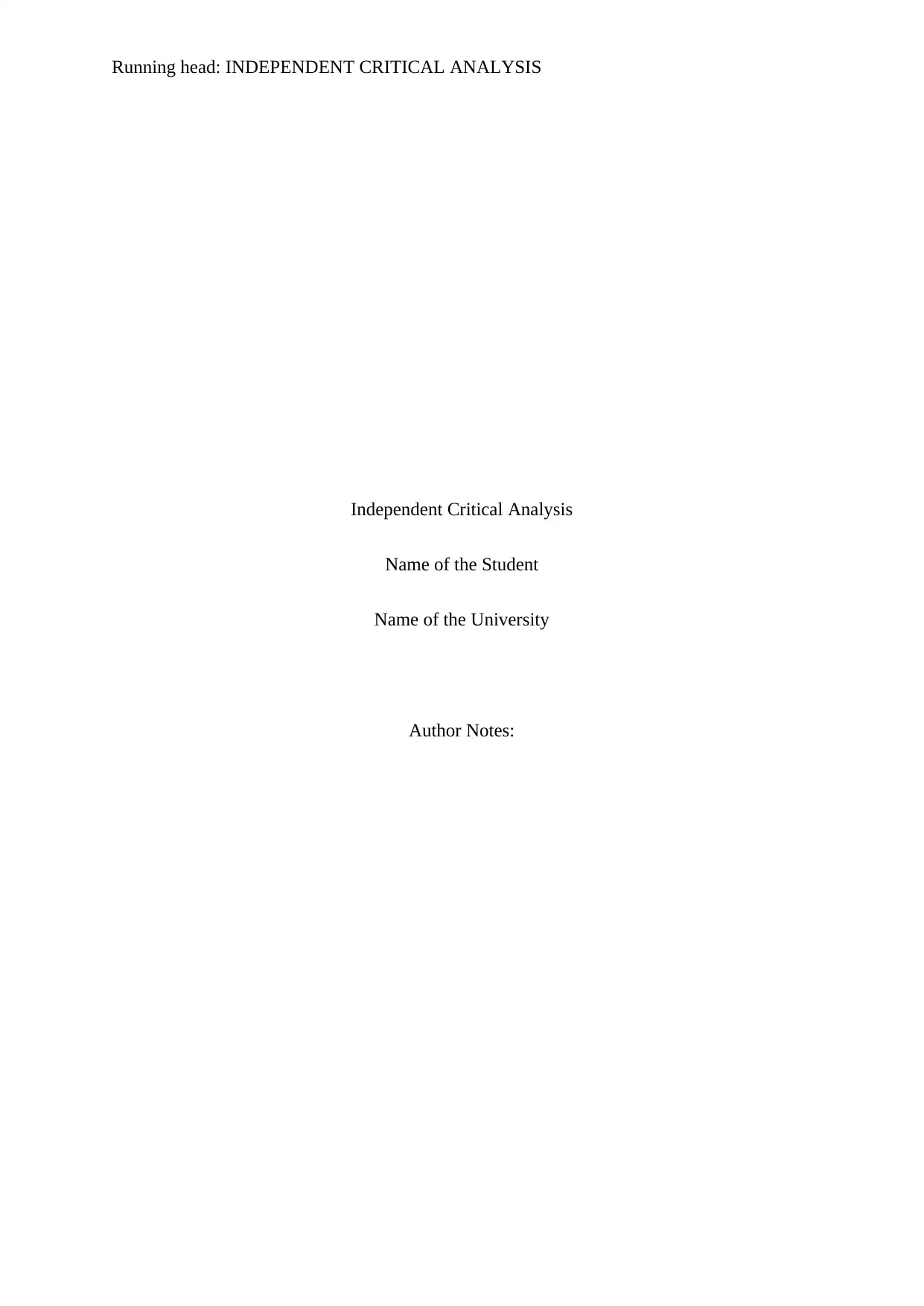
Running head: INDEPENDENT CRITICAL ANALYSIS
Independent Critical Analysis
Name of the Student
Name of the University
Author Notes:
Independent Critical Analysis
Name of the Student
Name of the University
Author Notes:
Paraphrase This Document
Need a fresh take? Get an instant paraphrase of this document with our AI Paraphraser
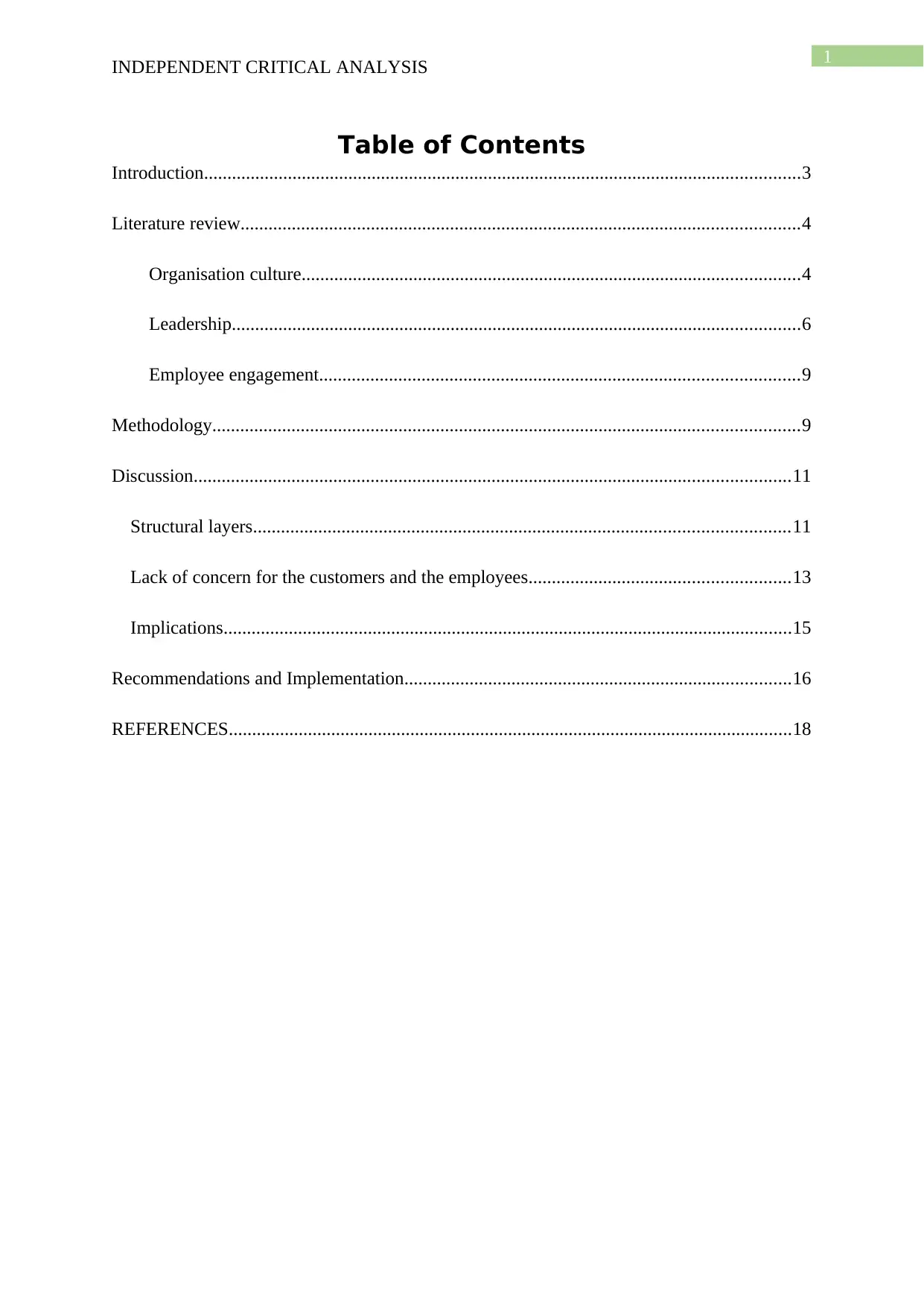
1
INDEPENDENT CRITICAL ANALYSIS
Table of Contents
Introduction................................................................................................................................3
Literature review........................................................................................................................4
Organisation culture...........................................................................................................4
Leadership..........................................................................................................................6
Employee engagement.......................................................................................................9
Methodology..............................................................................................................................9
Discussion................................................................................................................................11
Structural layers...................................................................................................................11
Lack of concern for the customers and the employees........................................................13
Implications..........................................................................................................................15
Recommendations and Implementation...................................................................................16
REFERENCES.........................................................................................................................18
INDEPENDENT CRITICAL ANALYSIS
Table of Contents
Introduction................................................................................................................................3
Literature review........................................................................................................................4
Organisation culture...........................................................................................................4
Leadership..........................................................................................................................6
Employee engagement.......................................................................................................9
Methodology..............................................................................................................................9
Discussion................................................................................................................................11
Structural layers...................................................................................................................11
Lack of concern for the customers and the employees........................................................13
Implications..........................................................................................................................15
Recommendations and Implementation...................................................................................16
REFERENCES.........................................................................................................................18
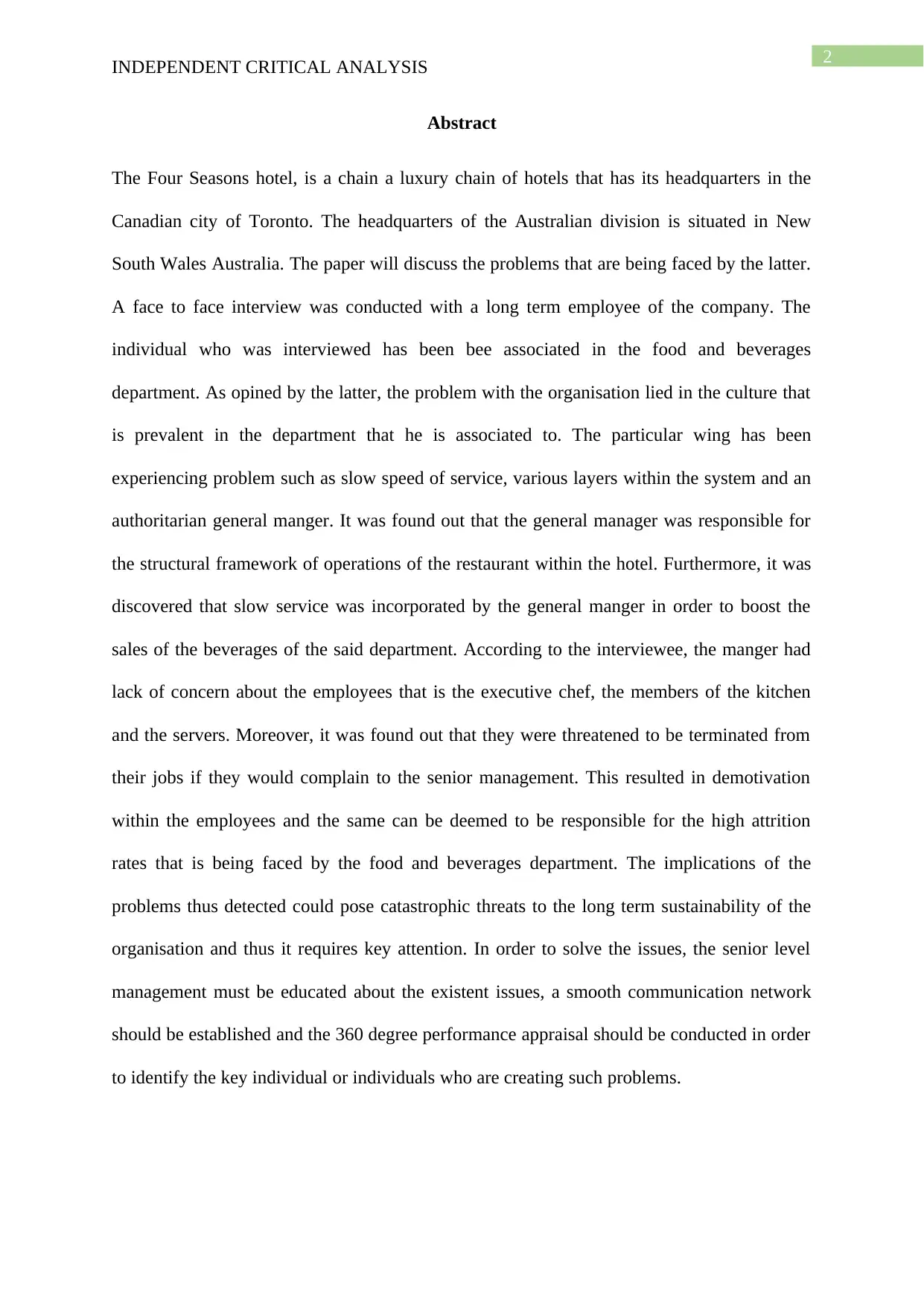
2
INDEPENDENT CRITICAL ANALYSIS
Abstract
The Four Seasons hotel, is a chain a luxury chain of hotels that has its headquarters in the
Canadian city of Toronto. The headquarters of the Australian division is situated in New
South Wales Australia. The paper will discuss the problems that are being faced by the latter.
A face to face interview was conducted with a long term employee of the company. The
individual who was interviewed has been bee associated in the food and beverages
department. As opined by the latter, the problem with the organisation lied in the culture that
is prevalent in the department that he is associated to. The particular wing has been
experiencing problem such as slow speed of service, various layers within the system and an
authoritarian general manger. It was found out that the general manager was responsible for
the structural framework of operations of the restaurant within the hotel. Furthermore, it was
discovered that slow service was incorporated by the general manger in order to boost the
sales of the beverages of the said department. According to the interviewee, the manger had
lack of concern about the employees that is the executive chef, the members of the kitchen
and the servers. Moreover, it was found out that they were threatened to be terminated from
their jobs if they would complain to the senior management. This resulted in demotivation
within the employees and the same can be deemed to be responsible for the high attrition
rates that is being faced by the food and beverages department. The implications of the
problems thus detected could pose catastrophic threats to the long term sustainability of the
organisation and thus it requires key attention. In order to solve the issues, the senior level
management must be educated about the existent issues, a smooth communication network
should be established and the 360 degree performance appraisal should be conducted in order
to identify the key individual or individuals who are creating such problems.
INDEPENDENT CRITICAL ANALYSIS
Abstract
The Four Seasons hotel, is a chain a luxury chain of hotels that has its headquarters in the
Canadian city of Toronto. The headquarters of the Australian division is situated in New
South Wales Australia. The paper will discuss the problems that are being faced by the latter.
A face to face interview was conducted with a long term employee of the company. The
individual who was interviewed has been bee associated in the food and beverages
department. As opined by the latter, the problem with the organisation lied in the culture that
is prevalent in the department that he is associated to. The particular wing has been
experiencing problem such as slow speed of service, various layers within the system and an
authoritarian general manger. It was found out that the general manager was responsible for
the structural framework of operations of the restaurant within the hotel. Furthermore, it was
discovered that slow service was incorporated by the general manger in order to boost the
sales of the beverages of the said department. According to the interviewee, the manger had
lack of concern about the employees that is the executive chef, the members of the kitchen
and the servers. Moreover, it was found out that they were threatened to be terminated from
their jobs if they would complain to the senior management. This resulted in demotivation
within the employees and the same can be deemed to be responsible for the high attrition
rates that is being faced by the food and beverages department. The implications of the
problems thus detected could pose catastrophic threats to the long term sustainability of the
organisation and thus it requires key attention. In order to solve the issues, the senior level
management must be educated about the existent issues, a smooth communication network
should be established and the 360 degree performance appraisal should be conducted in order
to identify the key individual or individuals who are creating such problems.
⊘ This is a preview!⊘
Do you want full access?
Subscribe today to unlock all pages.

Trusted by 1+ million students worldwide
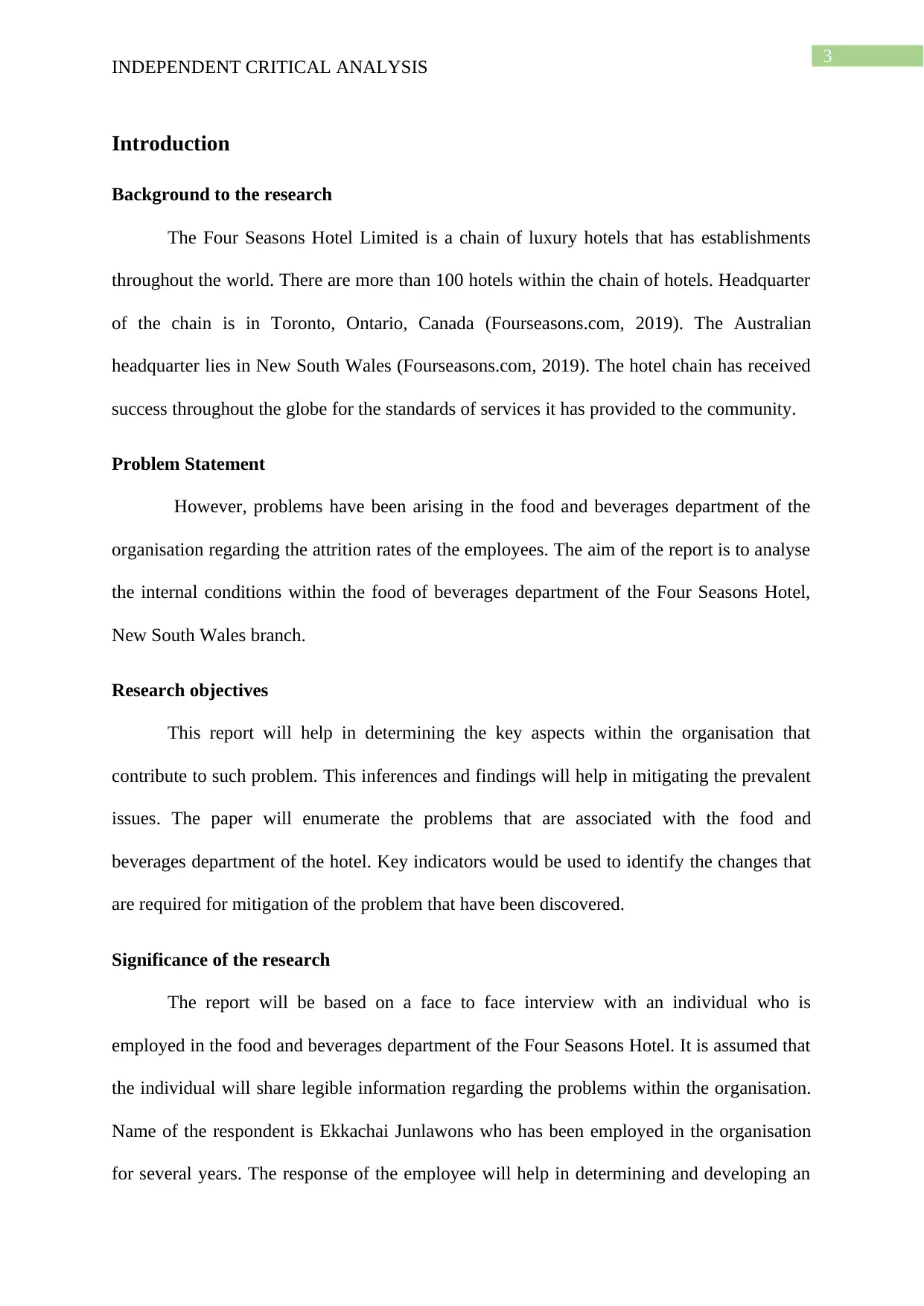
3
INDEPENDENT CRITICAL ANALYSIS
Introduction
Background to the research
The Four Seasons Hotel Limited is a chain of luxury hotels that has establishments
throughout the world. There are more than 100 hotels within the chain of hotels. Headquarter
of the chain is in Toronto, Ontario, Canada (Fourseasons.com, 2019). The Australian
headquarter lies in New South Wales (Fourseasons.com, 2019). The hotel chain has received
success throughout the globe for the standards of services it has provided to the community.
Problem Statement
However, problems have been arising in the food and beverages department of the
organisation regarding the attrition rates of the employees. The aim of the report is to analyse
the internal conditions within the food of beverages department of the Four Seasons Hotel,
New South Wales branch.
Research objectives
This report will help in determining the key aspects within the organisation that
contribute to such problem. This inferences and findings will help in mitigating the prevalent
issues. The paper will enumerate the problems that are associated with the food and
beverages department of the hotel. Key indicators would be used to identify the changes that
are required for mitigation of the problem that have been discovered.
Significance of the research
The report will be based on a face to face interview with an individual who is
employed in the food and beverages department of the Four Seasons Hotel. It is assumed that
the individual will share legible information regarding the problems within the organisation.
Name of the respondent is Ekkachai Junlawons who has been employed in the organisation
for several years. The response of the employee will help in determining and developing an
INDEPENDENT CRITICAL ANALYSIS
Introduction
Background to the research
The Four Seasons Hotel Limited is a chain of luxury hotels that has establishments
throughout the world. There are more than 100 hotels within the chain of hotels. Headquarter
of the chain is in Toronto, Ontario, Canada (Fourseasons.com, 2019). The Australian
headquarter lies in New South Wales (Fourseasons.com, 2019). The hotel chain has received
success throughout the globe for the standards of services it has provided to the community.
Problem Statement
However, problems have been arising in the food and beverages department of the
organisation regarding the attrition rates of the employees. The aim of the report is to analyse
the internal conditions within the food of beverages department of the Four Seasons Hotel,
New South Wales branch.
Research objectives
This report will help in determining the key aspects within the organisation that
contribute to such problem. This inferences and findings will help in mitigating the prevalent
issues. The paper will enumerate the problems that are associated with the food and
beverages department of the hotel. Key indicators would be used to identify the changes that
are required for mitigation of the problem that have been discovered.
Significance of the research
The report will be based on a face to face interview with an individual who is
employed in the food and beverages department of the Four Seasons Hotel. It is assumed that
the individual will share legible information regarding the problems within the organisation.
Name of the respondent is Ekkachai Junlawons who has been employed in the organisation
for several years. The response of the employee will help in determining and developing an
Paraphrase This Document
Need a fresh take? Get an instant paraphrase of this document with our AI Paraphraser
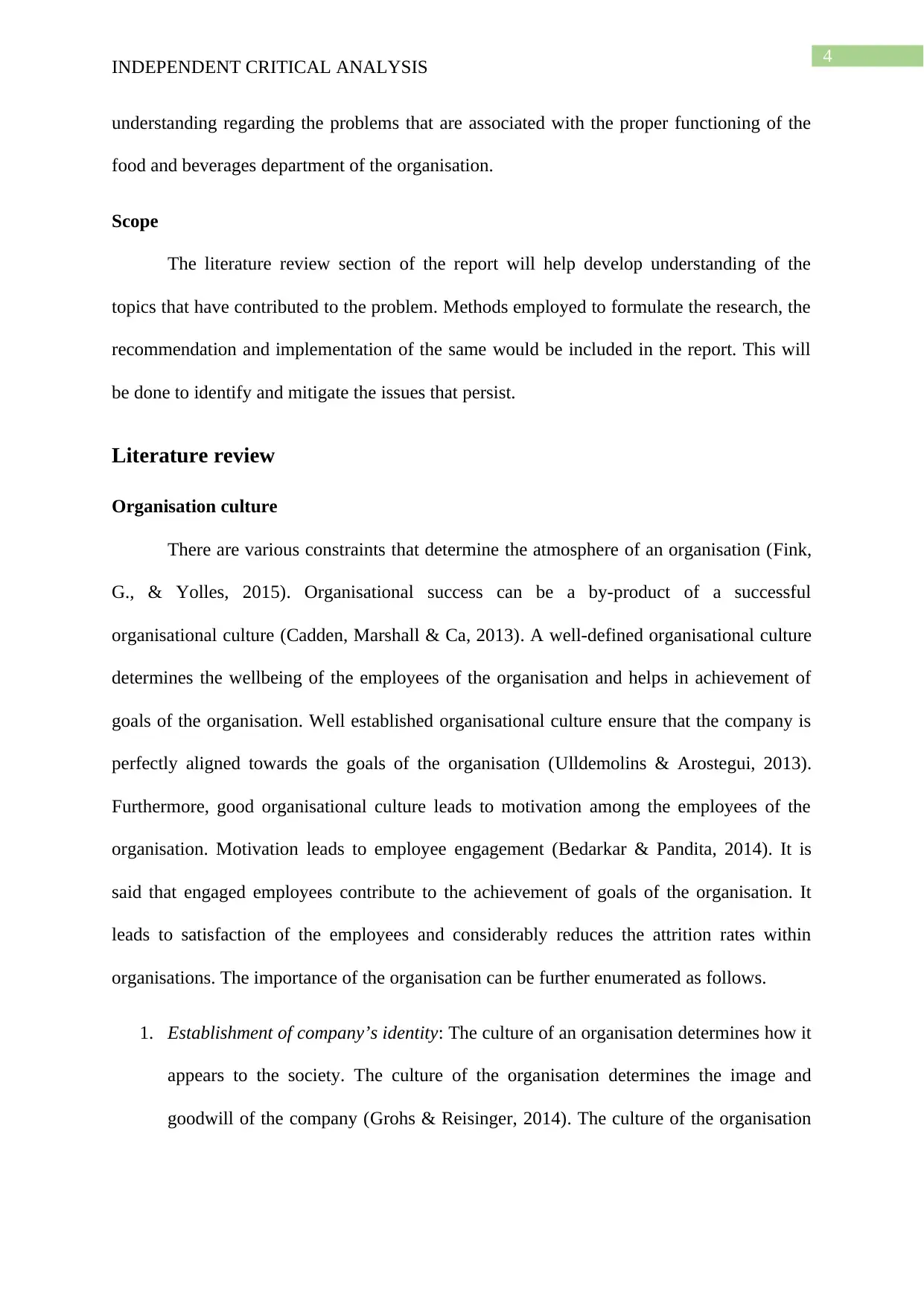
4
INDEPENDENT CRITICAL ANALYSIS
understanding regarding the problems that are associated with the proper functioning of the
food and beverages department of the organisation.
Scope
The literature review section of the report will help develop understanding of the
topics that have contributed to the problem. Methods employed to formulate the research, the
recommendation and implementation of the same would be included in the report. This will
be done to identify and mitigate the issues that persist.
Literature review
Organisation culture
There are various constraints that determine the atmosphere of an organisation (Fink,
G., & Yolles, 2015). Organisational success can be a by-product of a successful
organisational culture (Cadden, Marshall & Ca, 2013). A well-defined organisational culture
determines the wellbeing of the employees of the organisation and helps in achievement of
goals of the organisation. Well established organisational culture ensure that the company is
perfectly aligned towards the goals of the organisation (Ulldemolins & Arostegui, 2013).
Furthermore, good organisational culture leads to motivation among the employees of the
organisation. Motivation leads to employee engagement (Bedarkar & Pandita, 2014). It is
said that engaged employees contribute to the achievement of goals of the organisation. It
leads to satisfaction of the employees and considerably reduces the attrition rates within
organisations. The importance of the organisation can be further enumerated as follows.
1. Establishment of company’s identity: The culture of an organisation determines how it
appears to the society. The culture of the organisation determines the image and
goodwill of the company (Grohs & Reisinger, 2014). The culture of the organisation
INDEPENDENT CRITICAL ANALYSIS
understanding regarding the problems that are associated with the proper functioning of the
food and beverages department of the organisation.
Scope
The literature review section of the report will help develop understanding of the
topics that have contributed to the problem. Methods employed to formulate the research, the
recommendation and implementation of the same would be included in the report. This will
be done to identify and mitigate the issues that persist.
Literature review
Organisation culture
There are various constraints that determine the atmosphere of an organisation (Fink,
G., & Yolles, 2015). Organisational success can be a by-product of a successful
organisational culture (Cadden, Marshall & Ca, 2013). A well-defined organisational culture
determines the wellbeing of the employees of the organisation and helps in achievement of
goals of the organisation. Well established organisational culture ensure that the company is
perfectly aligned towards the goals of the organisation (Ulldemolins & Arostegui, 2013).
Furthermore, good organisational culture leads to motivation among the employees of the
organisation. Motivation leads to employee engagement (Bedarkar & Pandita, 2014). It is
said that engaged employees contribute to the achievement of goals of the organisation. It
leads to satisfaction of the employees and considerably reduces the attrition rates within
organisations. The importance of the organisation can be further enumerated as follows.
1. Establishment of company’s identity: The culture of an organisation determines how it
appears to the society. The culture of the organisation determines the image and
goodwill of the company (Grohs & Reisinger, 2014). The culture of the organisation
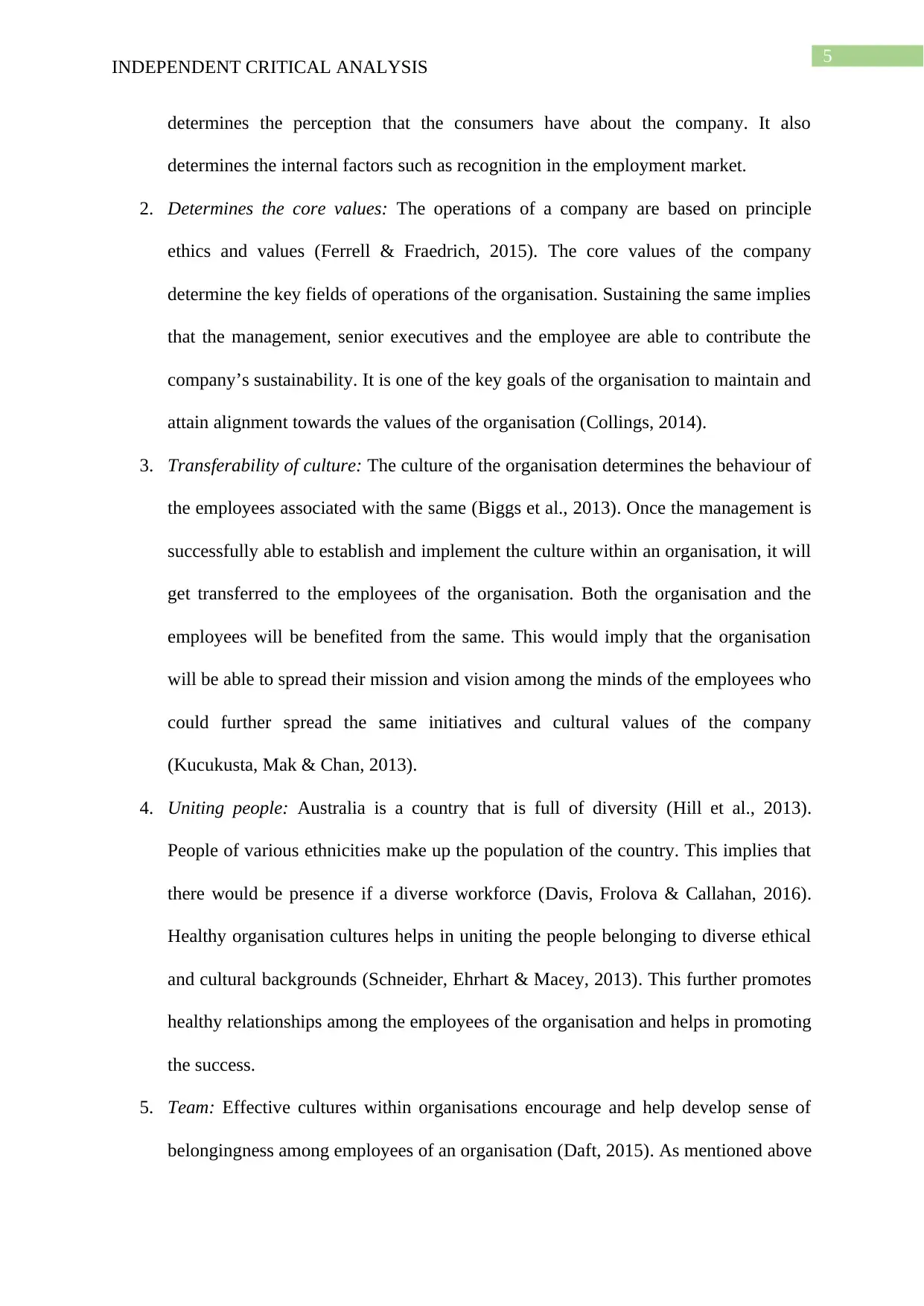
5
INDEPENDENT CRITICAL ANALYSIS
determines the perception that the consumers have about the company. It also
determines the internal factors such as recognition in the employment market.
2. Determines the core values: The operations of a company are based on principle
ethics and values (Ferrell & Fraedrich, 2015). The core values of the company
determine the key fields of operations of the organisation. Sustaining the same implies
that the management, senior executives and the employee are able to contribute the
company’s sustainability. It is one of the key goals of the organisation to maintain and
attain alignment towards the values of the organisation (Collings, 2014).
3. Transferability of culture: The culture of the organisation determines the behaviour of
the employees associated with the same (Biggs et al., 2013). Once the management is
successfully able to establish and implement the culture within an organisation, it will
get transferred to the employees of the organisation. Both the organisation and the
employees will be benefited from the same. This would imply that the organisation
will be able to spread their mission and vision among the minds of the employees who
could further spread the same initiatives and cultural values of the company
(Kucukusta, Mak & Chan, 2013).
4. Uniting people: Australia is a country that is full of diversity (Hill et al., 2013).
People of various ethnicities make up the population of the country. This implies that
there would be presence if a diverse workforce (Davis, Frolova & Callahan, 2016).
Healthy organisation cultures helps in uniting the people belonging to diverse ethical
and cultural backgrounds (Schneider, Ehrhart & Macey, 2013). This further promotes
healthy relationships among the employees of the organisation and helps in promoting
the success.
5. Team: Effective cultures within organisations encourage and help develop sense of
belongingness among employees of an organisation (Daft, 2015). As mentioned above
INDEPENDENT CRITICAL ANALYSIS
determines the perception that the consumers have about the company. It also
determines the internal factors such as recognition in the employment market.
2. Determines the core values: The operations of a company are based on principle
ethics and values (Ferrell & Fraedrich, 2015). The core values of the company
determine the key fields of operations of the organisation. Sustaining the same implies
that the management, senior executives and the employee are able to contribute the
company’s sustainability. It is one of the key goals of the organisation to maintain and
attain alignment towards the values of the organisation (Collings, 2014).
3. Transferability of culture: The culture of the organisation determines the behaviour of
the employees associated with the same (Biggs et al., 2013). Once the management is
successfully able to establish and implement the culture within an organisation, it will
get transferred to the employees of the organisation. Both the organisation and the
employees will be benefited from the same. This would imply that the organisation
will be able to spread their mission and vision among the minds of the employees who
could further spread the same initiatives and cultural values of the company
(Kucukusta, Mak & Chan, 2013).
4. Uniting people: Australia is a country that is full of diversity (Hill et al., 2013).
People of various ethnicities make up the population of the country. This implies that
there would be presence if a diverse workforce (Davis, Frolova & Callahan, 2016).
Healthy organisation cultures helps in uniting the people belonging to diverse ethical
and cultural backgrounds (Schneider, Ehrhart & Macey, 2013). This further promotes
healthy relationships among the employees of the organisation and helps in promoting
the success.
5. Team: Effective cultures within organisations encourage and help develop sense of
belongingness among employees of an organisation (Daft, 2015). As mentioned above
⊘ This is a preview!⊘
Do you want full access?
Subscribe today to unlock all pages.

Trusted by 1+ million students worldwide
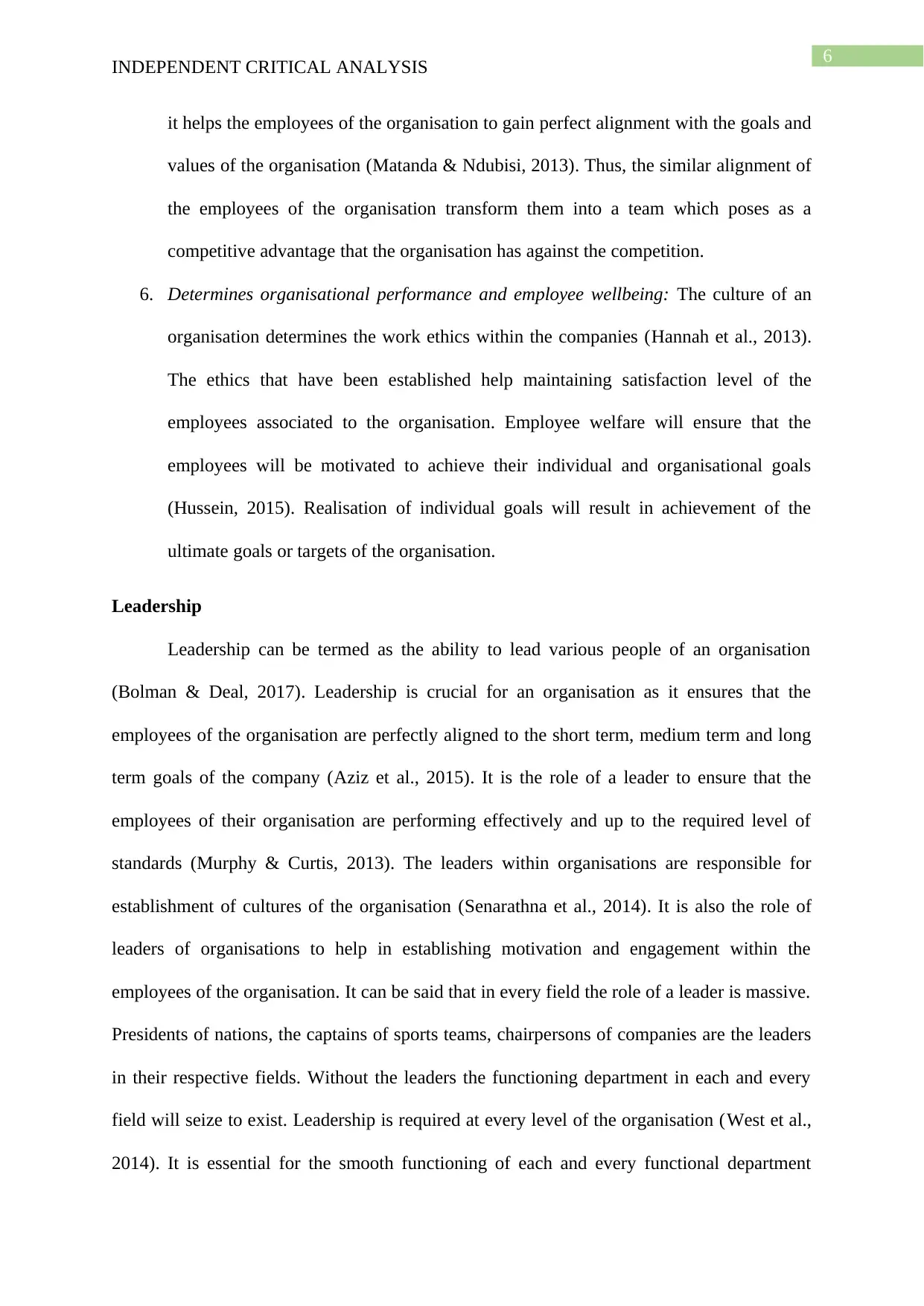
6
INDEPENDENT CRITICAL ANALYSIS
it helps the employees of the organisation to gain perfect alignment with the goals and
values of the organisation (Matanda & Ndubisi, 2013). Thus, the similar alignment of
the employees of the organisation transform them into a team which poses as a
competitive advantage that the organisation has against the competition.
6. Determines organisational performance and employee wellbeing: The culture of an
organisation determines the work ethics within the companies (Hannah et al., 2013).
The ethics that have been established help maintaining satisfaction level of the
employees associated to the organisation. Employee welfare will ensure that the
employees will be motivated to achieve their individual and organisational goals
(Hussein, 2015). Realisation of individual goals will result in achievement of the
ultimate goals or targets of the organisation.
Leadership
Leadership can be termed as the ability to lead various people of an organisation
(Bolman & Deal, 2017). Leadership is crucial for an organisation as it ensures that the
employees of the organisation are perfectly aligned to the short term, medium term and long
term goals of the company (Aziz et al., 2015). It is the role of a leader to ensure that the
employees of their organisation are performing effectively and up to the required level of
standards (Murphy & Curtis, 2013). The leaders within organisations are responsible for
establishment of cultures of the organisation (Senarathna et al., 2014). It is also the role of
leaders of organisations to help in establishing motivation and engagement within the
employees of the organisation. It can be said that in every field the role of a leader is massive.
Presidents of nations, the captains of sports teams, chairpersons of companies are the leaders
in their respective fields. Without the leaders the functioning department in each and every
field will seize to exist. Leadership is required at every level of the organisation (West et al.,
2014). It is essential for the smooth functioning of each and every functional department
INDEPENDENT CRITICAL ANALYSIS
it helps the employees of the organisation to gain perfect alignment with the goals and
values of the organisation (Matanda & Ndubisi, 2013). Thus, the similar alignment of
the employees of the organisation transform them into a team which poses as a
competitive advantage that the organisation has against the competition.
6. Determines organisational performance and employee wellbeing: The culture of an
organisation determines the work ethics within the companies (Hannah et al., 2013).
The ethics that have been established help maintaining satisfaction level of the
employees associated to the organisation. Employee welfare will ensure that the
employees will be motivated to achieve their individual and organisational goals
(Hussein, 2015). Realisation of individual goals will result in achievement of the
ultimate goals or targets of the organisation.
Leadership
Leadership can be termed as the ability to lead various people of an organisation
(Bolman & Deal, 2017). Leadership is crucial for an organisation as it ensures that the
employees of the organisation are perfectly aligned to the short term, medium term and long
term goals of the company (Aziz et al., 2015). It is the role of a leader to ensure that the
employees of their organisation are performing effectively and up to the required level of
standards (Murphy & Curtis, 2013). The leaders within organisations are responsible for
establishment of cultures of the organisation (Senarathna et al., 2014). It is also the role of
leaders of organisations to help in establishing motivation and engagement within the
employees of the organisation. It can be said that in every field the role of a leader is massive.
Presidents of nations, the captains of sports teams, chairpersons of companies are the leaders
in their respective fields. Without the leaders the functioning department in each and every
field will seize to exist. Leadership is required at every level of the organisation (West et al.,
2014). It is essential for the smooth functioning of each and every functional department
Paraphrase This Document
Need a fresh take? Get an instant paraphrase of this document with our AI Paraphraser
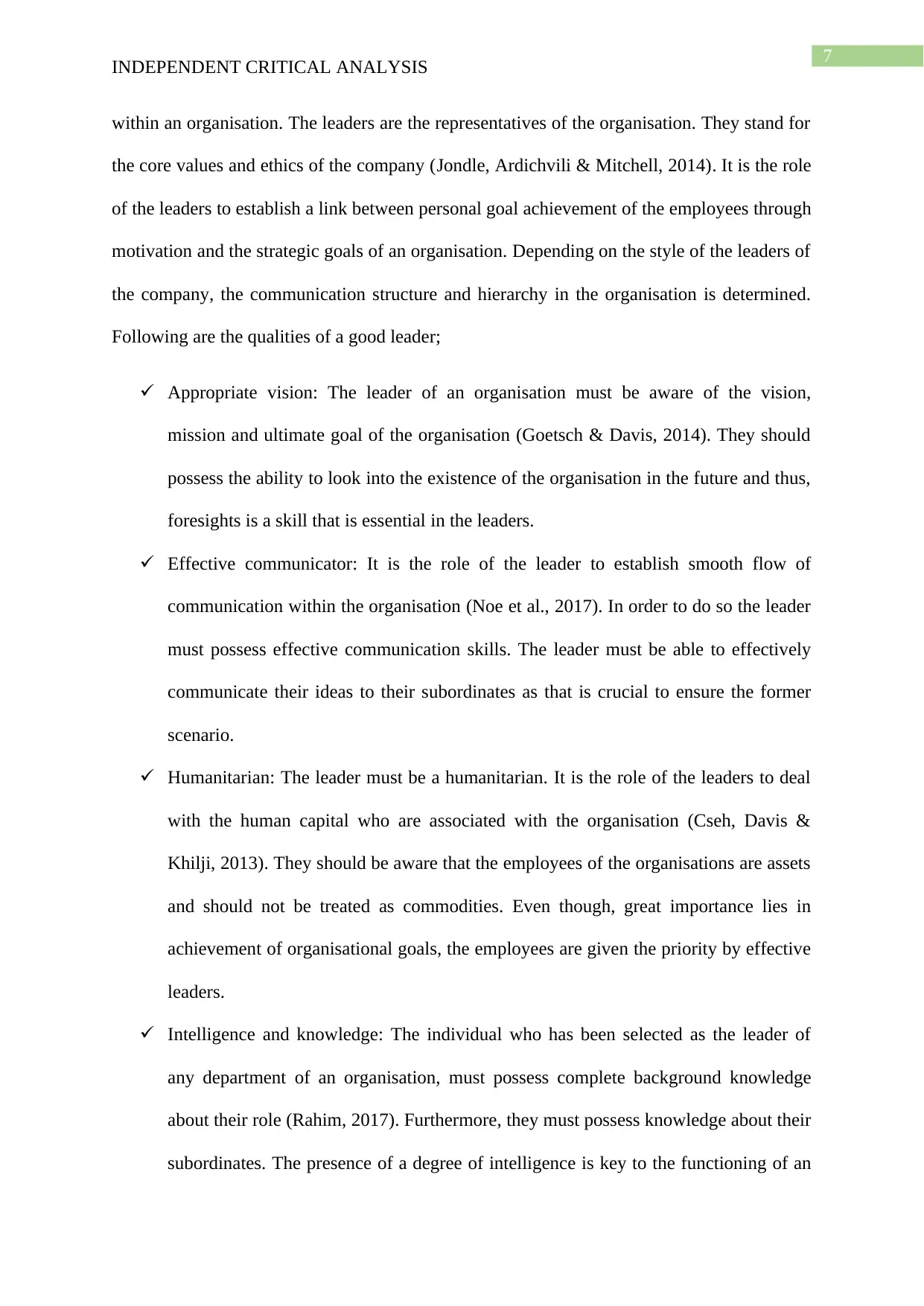
7
INDEPENDENT CRITICAL ANALYSIS
within an organisation. The leaders are the representatives of the organisation. They stand for
the core values and ethics of the company (Jondle, Ardichvili & Mitchell, 2014). It is the role
of the leaders to establish a link between personal goal achievement of the employees through
motivation and the strategic goals of an organisation. Depending on the style of the leaders of
the company, the communication structure and hierarchy in the organisation is determined.
Following are the qualities of a good leader;
Appropriate vision: The leader of an organisation must be aware of the vision,
mission and ultimate goal of the organisation (Goetsch & Davis, 2014). They should
possess the ability to look into the existence of the organisation in the future and thus,
foresights is a skill that is essential in the leaders.
Effective communicator: It is the role of the leader to establish smooth flow of
communication within the organisation (Noe et al., 2017). In order to do so the leader
must possess effective communication skills. The leader must be able to effectively
communicate their ideas to their subordinates as that is crucial to ensure the former
scenario.
Humanitarian: The leader must be a humanitarian. It is the role of the leaders to deal
with the human capital who are associated with the organisation (Cseh, Davis &
Khilji, 2013). They should be aware that the employees of the organisations are assets
and should not be treated as commodities. Even though, great importance lies in
achievement of organisational goals, the employees are given the priority by effective
leaders.
Intelligence and knowledge: The individual who has been selected as the leader of
any department of an organisation, must possess complete background knowledge
about their role (Rahim, 2017). Furthermore, they must possess knowledge about their
subordinates. The presence of a degree of intelligence is key to the functioning of an
INDEPENDENT CRITICAL ANALYSIS
within an organisation. The leaders are the representatives of the organisation. They stand for
the core values and ethics of the company (Jondle, Ardichvili & Mitchell, 2014). It is the role
of the leaders to establish a link between personal goal achievement of the employees through
motivation and the strategic goals of an organisation. Depending on the style of the leaders of
the company, the communication structure and hierarchy in the organisation is determined.
Following are the qualities of a good leader;
Appropriate vision: The leader of an organisation must be aware of the vision,
mission and ultimate goal of the organisation (Goetsch & Davis, 2014). They should
possess the ability to look into the existence of the organisation in the future and thus,
foresights is a skill that is essential in the leaders.
Effective communicator: It is the role of the leader to establish smooth flow of
communication within the organisation (Noe et al., 2017). In order to do so the leader
must possess effective communication skills. The leader must be able to effectively
communicate their ideas to their subordinates as that is crucial to ensure the former
scenario.
Humanitarian: The leader must be a humanitarian. It is the role of the leaders to deal
with the human capital who are associated with the organisation (Cseh, Davis &
Khilji, 2013). They should be aware that the employees of the organisations are assets
and should not be treated as commodities. Even though, great importance lies in
achievement of organisational goals, the employees are given the priority by effective
leaders.
Intelligence and knowledge: The individual who has been selected as the leader of
any department of an organisation, must possess complete background knowledge
about their role (Rahim, 2017). Furthermore, they must possess knowledge about their
subordinates. The presence of a degree of intelligence is key to the functioning of an
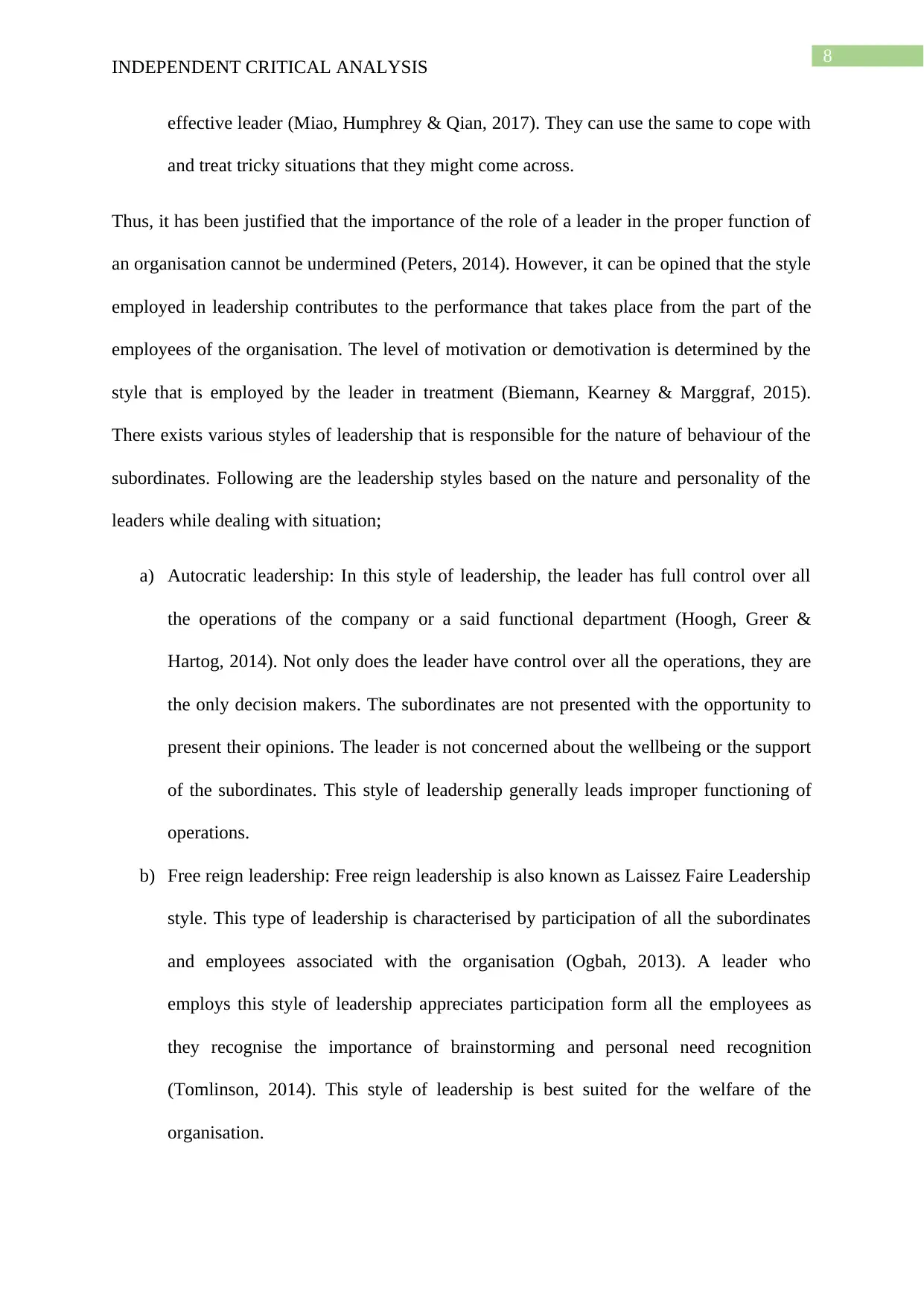
8
INDEPENDENT CRITICAL ANALYSIS
effective leader (Miao, Humphrey & Qian, 2017). They can use the same to cope with
and treat tricky situations that they might come across.
Thus, it has been justified that the importance of the role of a leader in the proper function of
an organisation cannot be undermined (Peters, 2014). However, it can be opined that the style
employed in leadership contributes to the performance that takes place from the part of the
employees of the organisation. The level of motivation or demotivation is determined by the
style that is employed by the leader in treatment (Biemann, Kearney & Marggraf, 2015).
There exists various styles of leadership that is responsible for the nature of behaviour of the
subordinates. Following are the leadership styles based on the nature and personality of the
leaders while dealing with situation;
a) Autocratic leadership: In this style of leadership, the leader has full control over all
the operations of the company or a said functional department (Hoogh, Greer &
Hartog, 2014). Not only does the leader have control over all the operations, they are
the only decision makers. The subordinates are not presented with the opportunity to
present their opinions. The leader is not concerned about the wellbeing or the support
of the subordinates. This style of leadership generally leads improper functioning of
operations.
b) Free reign leadership: Free reign leadership is also known as Laissez Faire Leadership
style. This type of leadership is characterised by participation of all the subordinates
and employees associated with the organisation (Ogbah, 2013). A leader who
employs this style of leadership appreciates participation form all the employees as
they recognise the importance of brainstorming and personal need recognition
(Tomlinson, 2014). This style of leadership is best suited for the welfare of the
organisation.
INDEPENDENT CRITICAL ANALYSIS
effective leader (Miao, Humphrey & Qian, 2017). They can use the same to cope with
and treat tricky situations that they might come across.
Thus, it has been justified that the importance of the role of a leader in the proper function of
an organisation cannot be undermined (Peters, 2014). However, it can be opined that the style
employed in leadership contributes to the performance that takes place from the part of the
employees of the organisation. The level of motivation or demotivation is determined by the
style that is employed by the leader in treatment (Biemann, Kearney & Marggraf, 2015).
There exists various styles of leadership that is responsible for the nature of behaviour of the
subordinates. Following are the leadership styles based on the nature and personality of the
leaders while dealing with situation;
a) Autocratic leadership: In this style of leadership, the leader has full control over all
the operations of the company or a said functional department (Hoogh, Greer &
Hartog, 2014). Not only does the leader have control over all the operations, they are
the only decision makers. The subordinates are not presented with the opportunity to
present their opinions. The leader is not concerned about the wellbeing or the support
of the subordinates. This style of leadership generally leads improper functioning of
operations.
b) Free reign leadership: Free reign leadership is also known as Laissez Faire Leadership
style. This type of leadership is characterised by participation of all the subordinates
and employees associated with the organisation (Ogbah, 2013). A leader who
employs this style of leadership appreciates participation form all the employees as
they recognise the importance of brainstorming and personal need recognition
(Tomlinson, 2014). This style of leadership is best suited for the welfare of the
organisation.
⊘ This is a preview!⊘
Do you want full access?
Subscribe today to unlock all pages.

Trusted by 1+ million students worldwide
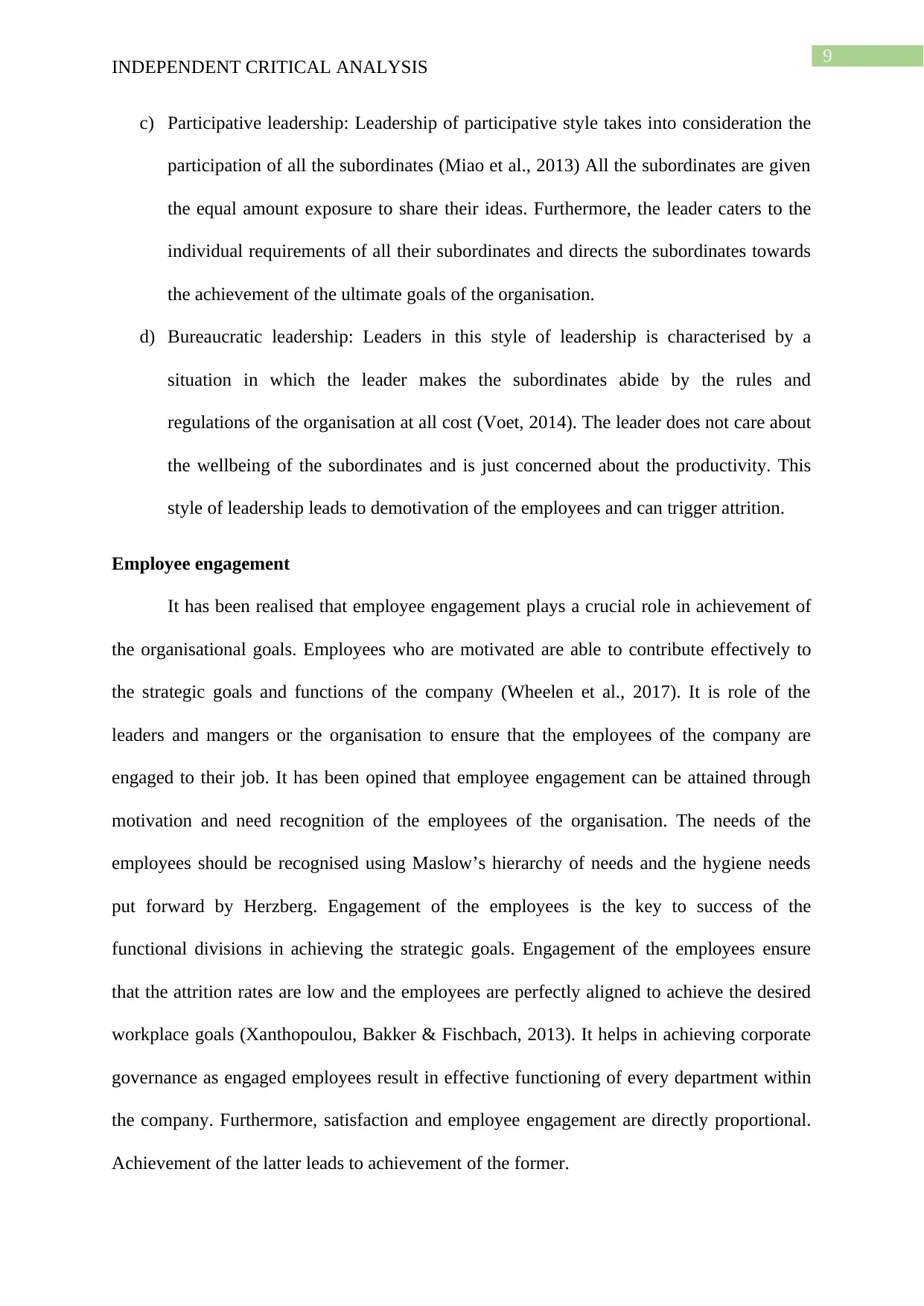
9
INDEPENDENT CRITICAL ANALYSIS
c) Participative leadership: Leadership of participative style takes into consideration the
participation of all the subordinates (Miao et al., 2013) All the subordinates are given
the equal amount exposure to share their ideas. Furthermore, the leader caters to the
individual requirements of all their subordinates and directs the subordinates towards
the achievement of the ultimate goals of the organisation.
d) Bureaucratic leadership: Leaders in this style of leadership is characterised by a
situation in which the leader makes the subordinates abide by the rules and
regulations of the organisation at all cost (Voet, 2014). The leader does not care about
the wellbeing of the subordinates and is just concerned about the productivity. This
style of leadership leads to demotivation of the employees and can trigger attrition.
Employee engagement
It has been realised that employee engagement plays a crucial role in achievement of
the organisational goals. Employees who are motivated are able to contribute effectively to
the strategic goals and functions of the company (Wheelen et al., 2017). It is role of the
leaders and mangers or the organisation to ensure that the employees of the company are
engaged to their job. It has been opined that employee engagement can be attained through
motivation and need recognition of the employees of the organisation. The needs of the
employees should be recognised using Maslow’s hierarchy of needs and the hygiene needs
put forward by Herzberg. Engagement of the employees is the key to success of the
functional divisions in achieving the strategic goals. Engagement of the employees ensure
that the attrition rates are low and the employees are perfectly aligned to achieve the desired
workplace goals (Xanthopoulou, Bakker & Fischbach, 2013). It helps in achieving corporate
governance as engaged employees result in effective functioning of every department within
the company. Furthermore, satisfaction and employee engagement are directly proportional.
Achievement of the latter leads to achievement of the former.
INDEPENDENT CRITICAL ANALYSIS
c) Participative leadership: Leadership of participative style takes into consideration the
participation of all the subordinates (Miao et al., 2013) All the subordinates are given
the equal amount exposure to share their ideas. Furthermore, the leader caters to the
individual requirements of all their subordinates and directs the subordinates towards
the achievement of the ultimate goals of the organisation.
d) Bureaucratic leadership: Leaders in this style of leadership is characterised by a
situation in which the leader makes the subordinates abide by the rules and
regulations of the organisation at all cost (Voet, 2014). The leader does not care about
the wellbeing of the subordinates and is just concerned about the productivity. This
style of leadership leads to demotivation of the employees and can trigger attrition.
Employee engagement
It has been realised that employee engagement plays a crucial role in achievement of
the organisational goals. Employees who are motivated are able to contribute effectively to
the strategic goals and functions of the company (Wheelen et al., 2017). It is role of the
leaders and mangers or the organisation to ensure that the employees of the company are
engaged to their job. It has been opined that employee engagement can be attained through
motivation and need recognition of the employees of the organisation. The needs of the
employees should be recognised using Maslow’s hierarchy of needs and the hygiene needs
put forward by Herzberg. Engagement of the employees is the key to success of the
functional divisions in achieving the strategic goals. Engagement of the employees ensure
that the attrition rates are low and the employees are perfectly aligned to achieve the desired
workplace goals (Xanthopoulou, Bakker & Fischbach, 2013). It helps in achieving corporate
governance as engaged employees result in effective functioning of every department within
the company. Furthermore, satisfaction and employee engagement are directly proportional.
Achievement of the latter leads to achievement of the former.
Paraphrase This Document
Need a fresh take? Get an instant paraphrase of this document with our AI Paraphraser
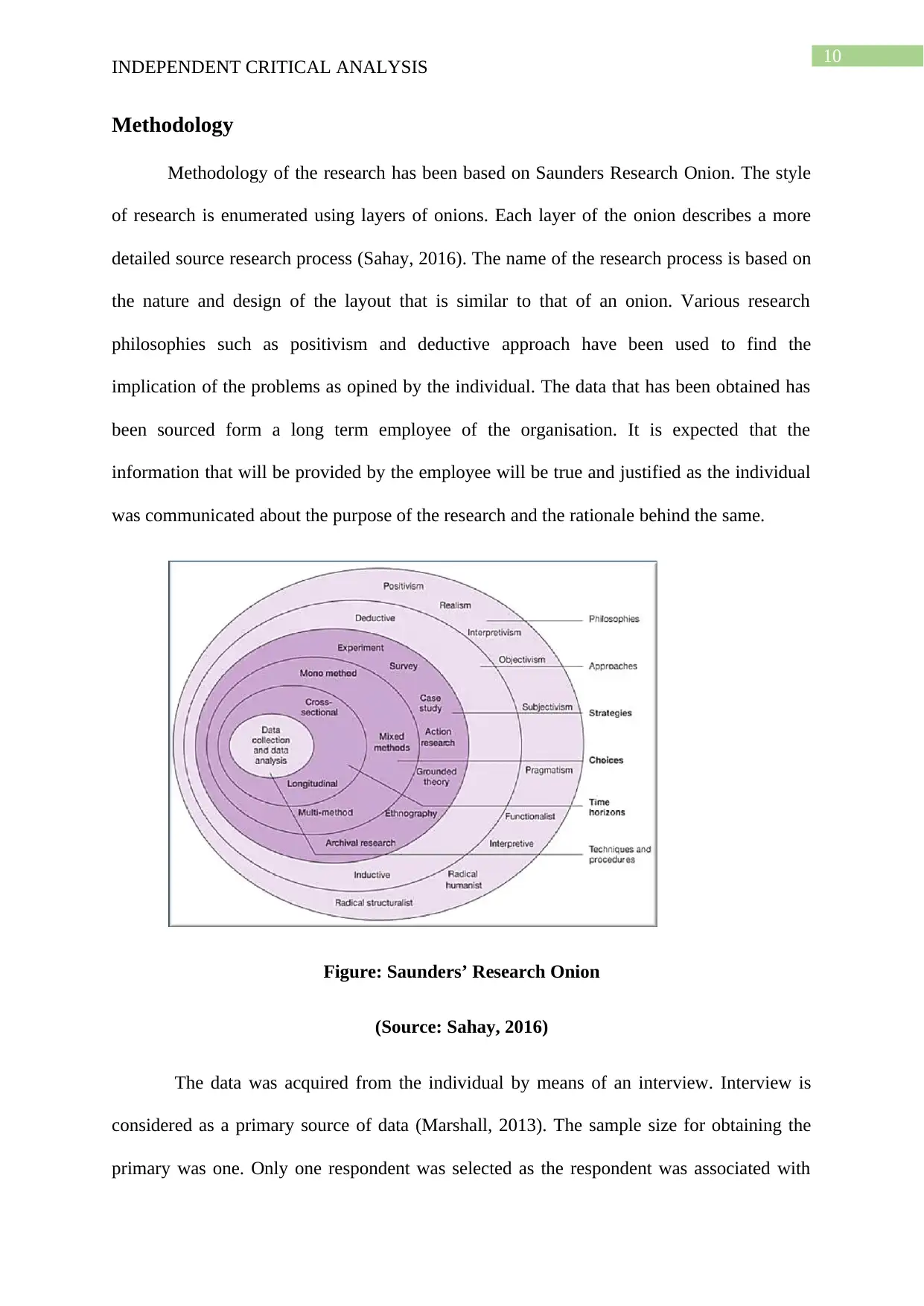
10
INDEPENDENT CRITICAL ANALYSIS
Methodology
Methodology of the research has been based on Saunders Research Onion. The style
of research is enumerated using layers of onions. Each layer of the onion describes a more
detailed source research process (Sahay, 2016). The name of the research process is based on
the nature and design of the layout that is similar to that of an onion. Various research
philosophies such as positivism and deductive approach have been used to find the
implication of the problems as opined by the individual. The data that has been obtained has
been sourced form a long term employee of the organisation. It is expected that the
information that will be provided by the employee will be true and justified as the individual
was communicated about the purpose of the research and the rationale behind the same.
Figure: Saunders’ Research Onion
(Source: Sahay, 2016)
The data was acquired from the individual by means of an interview. Interview is
considered as a primary source of data (Marshall, 2013). The sample size for obtaining the
primary was one. Only one respondent was selected as the respondent was associated with
INDEPENDENT CRITICAL ANALYSIS
Methodology
Methodology of the research has been based on Saunders Research Onion. The style
of research is enumerated using layers of onions. Each layer of the onion describes a more
detailed source research process (Sahay, 2016). The name of the research process is based on
the nature and design of the layout that is similar to that of an onion. Various research
philosophies such as positivism and deductive approach have been used to find the
implication of the problems as opined by the individual. The data that has been obtained has
been sourced form a long term employee of the organisation. It is expected that the
information that will be provided by the employee will be true and justified as the individual
was communicated about the purpose of the research and the rationale behind the same.
Figure: Saunders’ Research Onion
(Source: Sahay, 2016)
The data was acquired from the individual by means of an interview. Interview is
considered as a primary source of data (Marshall, 2013). The sample size for obtaining the
primary was one. Only one respondent was selected as the respondent was associated with
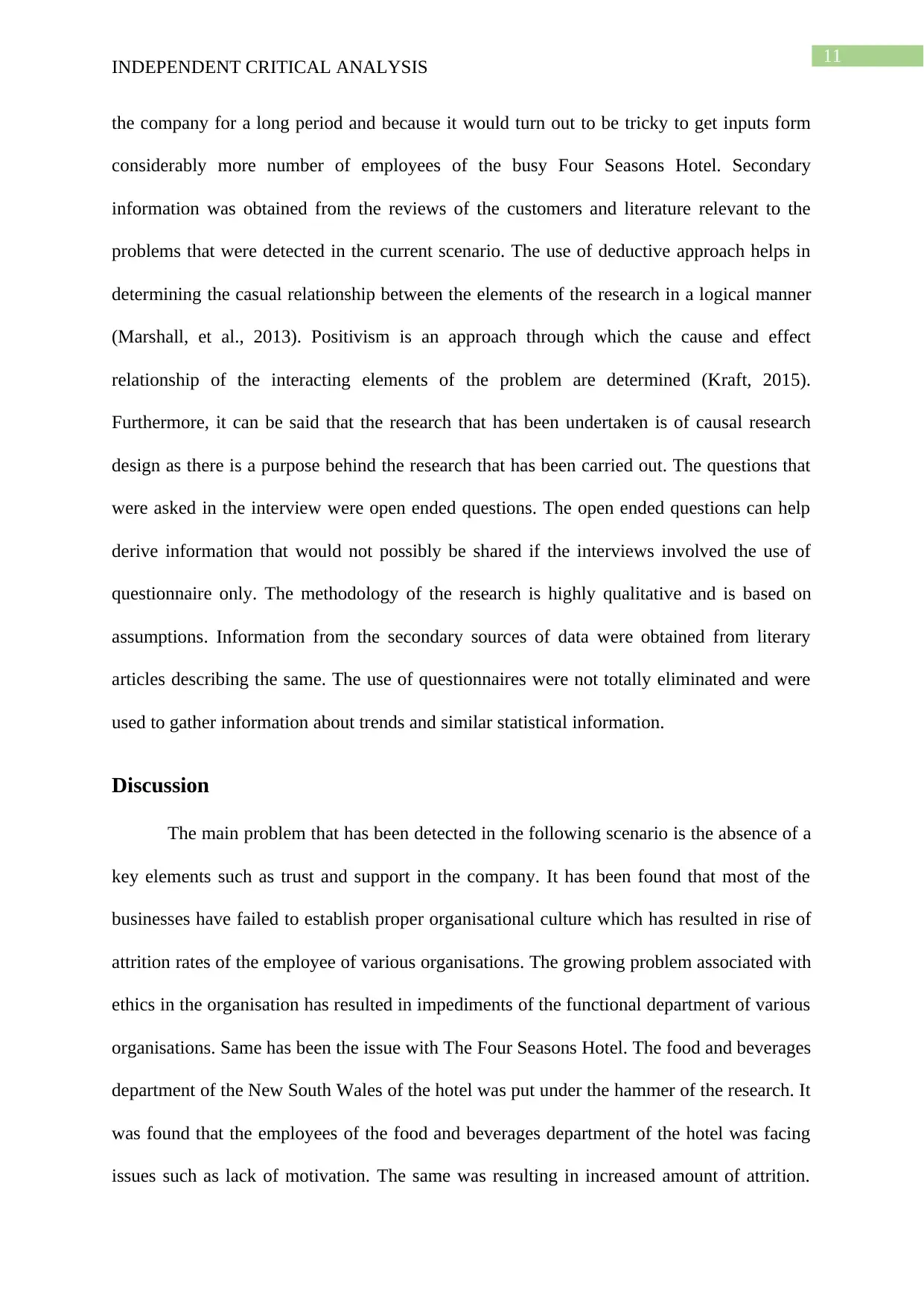
11
INDEPENDENT CRITICAL ANALYSIS
the company for a long period and because it would turn out to be tricky to get inputs form
considerably more number of employees of the busy Four Seasons Hotel. Secondary
information was obtained from the reviews of the customers and literature relevant to the
problems that were detected in the current scenario. The use of deductive approach helps in
determining the casual relationship between the elements of the research in a logical manner
(Marshall, et al., 2013). Positivism is an approach through which the cause and effect
relationship of the interacting elements of the problem are determined (Kraft, 2015).
Furthermore, it can be said that the research that has been undertaken is of causal research
design as there is a purpose behind the research that has been carried out. The questions that
were asked in the interview were open ended questions. The open ended questions can help
derive information that would not possibly be shared if the interviews involved the use of
questionnaire only. The methodology of the research is highly qualitative and is based on
assumptions. Information from the secondary sources of data were obtained from literary
articles describing the same. The use of questionnaires were not totally eliminated and were
used to gather information about trends and similar statistical information.
Discussion
The main problem that has been detected in the following scenario is the absence of a
key elements such as trust and support in the company. It has been found that most of the
businesses have failed to establish proper organisational culture which has resulted in rise of
attrition rates of the employee of various organisations. The growing problem associated with
ethics in the organisation has resulted in impediments of the functional department of various
organisations. Same has been the issue with The Four Seasons Hotel. The food and beverages
department of the New South Wales of the hotel was put under the hammer of the research. It
was found that the employees of the food and beverages department of the hotel was facing
issues such as lack of motivation. The same was resulting in increased amount of attrition.
INDEPENDENT CRITICAL ANALYSIS
the company for a long period and because it would turn out to be tricky to get inputs form
considerably more number of employees of the busy Four Seasons Hotel. Secondary
information was obtained from the reviews of the customers and literature relevant to the
problems that were detected in the current scenario. The use of deductive approach helps in
determining the casual relationship between the elements of the research in a logical manner
(Marshall, et al., 2013). Positivism is an approach through which the cause and effect
relationship of the interacting elements of the problem are determined (Kraft, 2015).
Furthermore, it can be said that the research that has been undertaken is of causal research
design as there is a purpose behind the research that has been carried out. The questions that
were asked in the interview were open ended questions. The open ended questions can help
derive information that would not possibly be shared if the interviews involved the use of
questionnaire only. The methodology of the research is highly qualitative and is based on
assumptions. Information from the secondary sources of data were obtained from literary
articles describing the same. The use of questionnaires were not totally eliminated and were
used to gather information about trends and similar statistical information.
Discussion
The main problem that has been detected in the following scenario is the absence of a
key elements such as trust and support in the company. It has been found that most of the
businesses have failed to establish proper organisational culture which has resulted in rise of
attrition rates of the employee of various organisations. The growing problem associated with
ethics in the organisation has resulted in impediments of the functional department of various
organisations. Same has been the issue with The Four Seasons Hotel. The food and beverages
department of the New South Wales of the hotel was put under the hammer of the research. It
was found that the employees of the food and beverages department of the hotel was facing
issues such as lack of motivation. The same was resulting in increased amount of attrition.
⊘ This is a preview!⊘
Do you want full access?
Subscribe today to unlock all pages.

Trusted by 1+ million students worldwide
1 out of 24
Your All-in-One AI-Powered Toolkit for Academic Success.
+13062052269
info@desklib.com
Available 24*7 on WhatsApp / Email
![[object Object]](/_next/static/media/star-bottom.7253800d.svg)
Unlock your academic potential
Copyright © 2020–2025 A2Z Services. All Rights Reserved. Developed and managed by ZUCOL.
